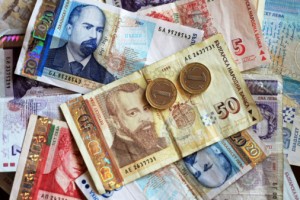Bulgarian Lev – BGN
Short facts about BGN – Bulgarian Lev
![]()
Read our in-depth guide about the Bulgarian Lev (BGN) below:
- Common names for Bulgarian Lev
- Countries with Bulgarian Lev
- How much is the Bulgarian Lev traded?
- Currency symbol and ISO-code
- Currency crisis with Bulgarian Lev
- The Bulgarian National Bank
- Online Forex Trading with Bulgarian Lev
- History of the Bulgarian Lev
- BGN vs other currencies
- Pictures of Bulgarian Lev
Common names for BGN
The lev (plural leva when used with a numeral, levove otherwise) is the currency of Bulgaria. 100 stotinki make one lev. In Bulgarian the lev is written as лев. Its nickname is kint (masculine) or kinta (feminine).
Countries with BGN
The lev (in various issues) has been the currency of Bulgaria since 1881.
Unofficial BGN countries
No other country uses the Bulgarian lev (BGN).
How much are the BGN traded?
The lev is pegged at a fixed rate to the Euro, and the currency is often difficult to obtain outside Bulgaria. For these reasons the BGN is not frequently traded; the euro being more readily available is preferred by traders.
Currency symbol and ISO-code
The symbol for lev is its first and last letters in Cyrillic script: лв, and its ISO-code is BGN. Before 1999 its code was BGL; this is now obsolete.
Currency crisis with BGN
The Republic of Bulgaria moved towards a market economy in the post-Communist era of the 1990s, but for a number of years it faced high levels of inflation. To deal with this, the government devalued the lev in 1997 and pegged it at par with the German mark. The country saw its greatest levels of growth between the years 2003 and 2008. However, by the end of 2008 the rate of growth fell due to the impact of the global financial crisis. Further difficulties followed in 2009 as Bulgaria was exposed to the effects of the gas dispute between Russia and the Ukraine. During 2009 the newly-elected government introduced a tighter fiscal policy, and by the end of the year Bulgaria had become the only EU nation to achieve a positive upgrade in Standard and Poors’ investment outlook, its rating moving from ‘negative’ to ‘stable’. It received a further rating of ‘positive’ from Moody’s in 2010, despite unemployment remaining at a high level.
Central Bank for BGN
The Bulgarian National Bank (BNB) is the state bank for the Republic of Bulgaria and responsible for maintaining the stability of BGN. All levove in circulation are backed totally by the BNB’s foreign exchange reserves.
Trade BGN
The BGN is managed by a currency board to maintain its fixed exchange rate with the euro. Its trade is therefore entirely dependent on the value of the euro.
History of the BGN
There have been four issues of the lev throughout the history of the Bulgarian nation. At various times the lev has been pegged to different foreign currencies, including the French franc, the German mark, the Russian rouble and the US dollar. It has also been backed by gold at different stages in its history.
The current issue of the lev was established in 1999 and the code BGN was introduced specifically for this currency. This issue of the lev was pegged at par with the German mark. With the introduction of the euro in 2002, the value of BGN has been pegged to the euro at the same level as the mark (1.95583 leva = 1 euro). This is the German currency’s fixed exchange rate with the euro.
In 2007 Bulgaria became a member of the EU and was expected to join the euro in 2012. However, this is not likely to happen before 2015 at the earliest. The BGN is pegged to the euro in any case, and the present difficulties in the Eurozone might not persuade the Bulgarian government to move towards joining in the near future. The high rate of inflation in Bulgaria might raise difficulties also. Bulgaria meets four of the five criteria specified in the Maastricht Treaty for joining the euro.
BGN vs other currencies
Since 2002 the BGN has been pegged to the euro at a rate of 1 euro = 1.95583 leva. It therefore exchanges against all other currencies in relation to the euro’s rate of exchange.
Pictures of BGN notes and coins
The notes and coins of the Bulgarian lev (BGN) are pictured below:






